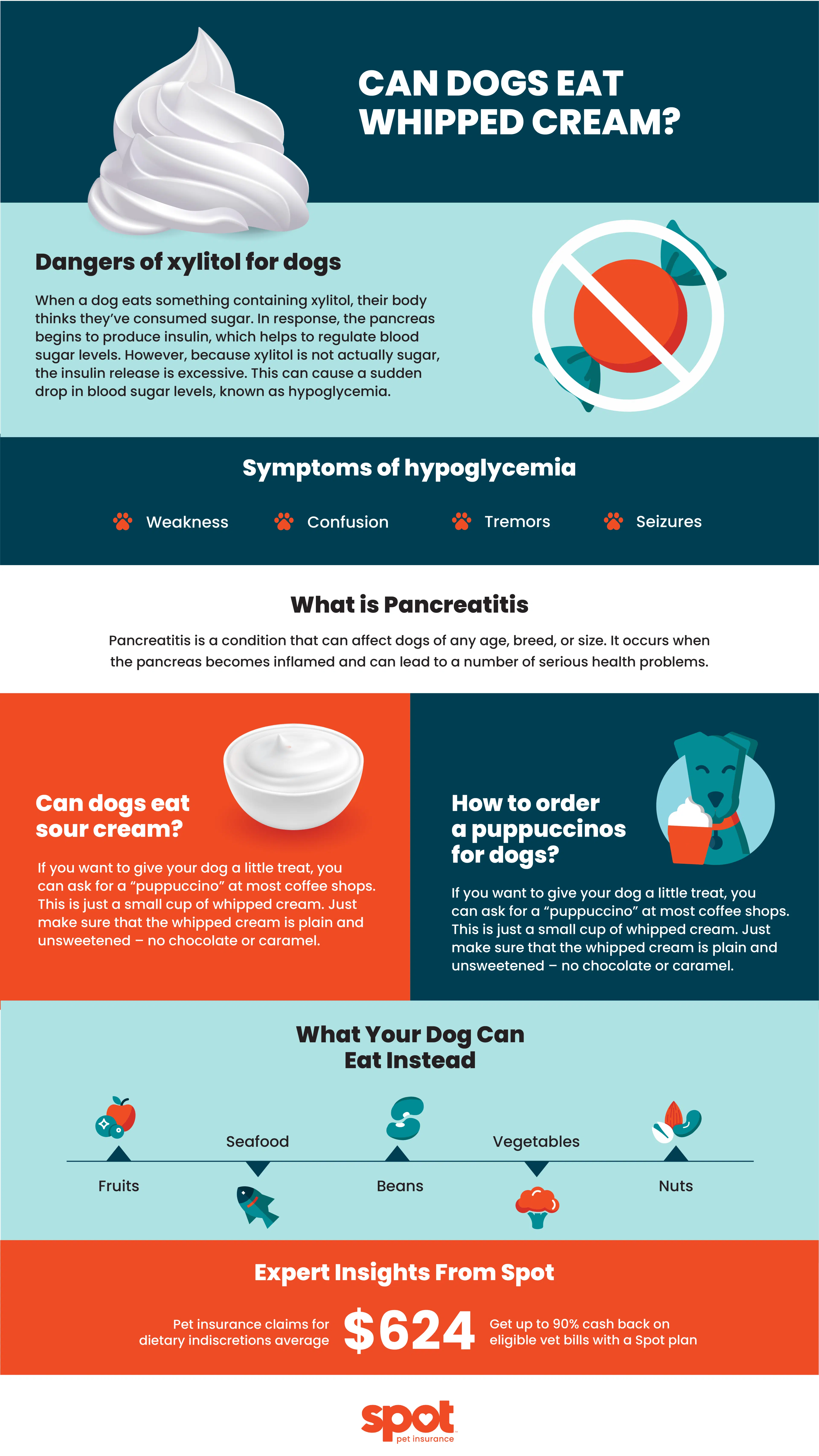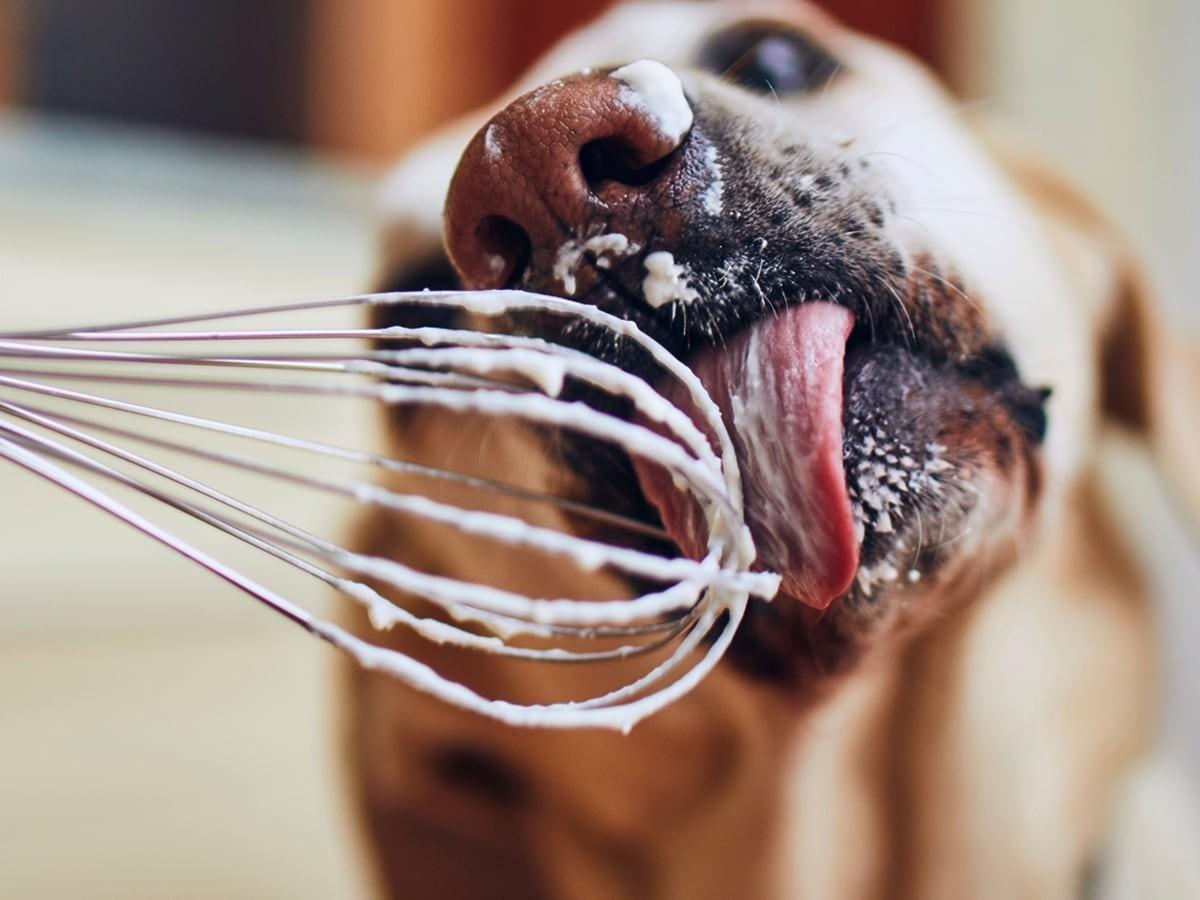Dogs and whipped cream: a match made in heaven? Some pet owners might think so, while others might be skeptical. So, what’s the verdict? Can dogs eat whipped cream or not? The answer might surprise you. Keep reading to find out more!
Whipped cream is one of those things that people know about but might not really understand what it is. Is it like cream cheese? Is it dairy? Is it a sauce? What’s the deal? It’s just cream, with a bit of sugar and vanilla extract added for flavor. Simple, right? It’s perfect for topping off desserts or even just enjoying on its own!
Although whipping cream is tasty and safe for humans to consume, it’s not necessarily the best choice for dogs in excess. Moderation is key and the selection must be plain when asking can dogs eat whipped cream or can dogs eat sour cream.
If you’re a dog owner, you’ve probably heard of xylitol. This sugar-free sweetener is found in many sugar-free products like chewing gum, candy, baked goods, and even some toothpastes. Although xylitol is perfectly safe for human consumption, it can be deadly for dogs.1

Dangers of Xylitol for Dogs
When a dog eats something containing xylitol, their body thinks they’ve consumed sugar. In response, the pancreas begins to produce insulin, which helps to regulate blood sugar levels. However, because xylitol is not actually sugar, the insulin release is excessive. This can cause a sudden drop in blood sugar levels, known as hypoglycemia.1
Symptoms of hypoglycemia can include weakness, confusion, tremors, and vomiting. Left untreated, hypoglycemia can lead to coma and seizures.1
In addition to causing hypoglycemia, xylitol can also damage the liver. When the liver can’t process insulin properly, it can become overloaded with toxins. This can lead to liver failure, which can require prolonged treatment.1
If you’re wondering whether it’s safe to give your dog a lick of whipped cream from your coffee or let them chew on that piece of sugar-free gum, the answer is no. Xylitol is dangerous for dogs, and it’s best to avoid it altogether. Can dogs eat whipped cream? Not if there is even a trace of xylitol.
Dogs and Dairy
As any pet owner knows, dogs can be very finicky eaters. Although they may enjoy the occasional treat, their digestive systems are not always able to handle foods that are designed for humans. One of the most common problems is dairy. Dogs can’t tolerate dairy very well for a number of reasons. First of all, they lack the enzymes necessary to break down lactose, which can lead to stomach upset and diarrhea.2
Pooches are more likely than humans to be allergic to milk proteins. For these reasons, it’s best to avoid giving your dog dairy products altogether. If you do decide to give your dog a little bit of cheese or ice cream, be sure to watch them closely for any signs of discomfort.
Pancreatitis in Dogs
Pancreatitis is a condition that can affect dogs of any age, breed, or size. It occurs when the pancreas becomes inflamed and can lead to a number of serious health problems. Symptoms of pancreatitis can include vomiting, diarrhea, abdominal pain, loss of appetite, and weight loss. If left untreated, pancreatitis can be fatal. There are many potential causes of pancreatitis in dogs, including dietary indiscretion (eating foods that they shouldn’t), certain medications, and infections.3
Although there is no one definitive way to prevent pancreatitis in dogs, it is essential to feed them a balanced diet and avoid giving them table scraps or other high-fat foods.3 If you think your dog may be showing signs of pancreatitis, it is important to take them to the vet for diagnosis and treatment.
Treatment for Pancreatitis in Dogs
Acute pancreatitis can be treated with rest, IV fluids, pain relief, and careful monitoring. If your dog has a more severe case of pancreatitis, they may need to be hospitalized. Treatment for chronic pancreatitis may include special diets, supplements, and medications.3
How to Order Puppuccinos for Dogs
If you want to give your dog a little treat, you can ask for a “puppuccino” at most coffee shops. This is just a small cup of whipped cream, and it’s the perfect size for a dog to enjoy. Just make sure that the whipped cream is plain and unsweetened – no chocolate or caramel. Starbucks is a good option for a treat when at home or on the road if it doesn’t have grapes, raisins, or chocolate.
Can Dogs Eat Sour Cream?
If dogs can enjoy whipped cream with a few caveats, can dogs eat sour cream? It depends. Sour cream is usually safe for dogs to eat in moderation. However, like other dairy products, it’s not the best for them to eat on a regular basis. Too much can cause digestive issues, so it’s best to keep it as a rare treat.2 If your dog does seem to have trouble digesting dairy, there are some specially-made dog foods that are dairy-free.
Expert Insights From Spot
While sharing our favorite foods with our pets can be tempting, it's important to remember that not all human foods are safe for dogs. Spot's internal data shows that pet insurance claims for dietary indiscretions average $642*, highlighting the importance of caution and research before sharing snacks with your pet.
What Your Dog Can Eat Instead
There’s no shame in wanting to give our dogs whatever food will make them happy. There just happens to be many other choices out there that are much healthier and more nutritious than pretzels. Here is a list of all the junk foods that your dog can eat.4
Fruits
There are many fruits that dogs can eat which are packed with vitamins, dietary fibers, and antioxidants. The best are berries like strawberries, blueberries, cranberries, and raspberries. Dogs can eat bananas, oranges, apples, melons, mangos, and pineapples. Make sure fruits with pits, stems, cores, and seeds have been ridden from these items. Several of them are choking hazards and peach pits can be toxic. Grapes of any kind are poisonous to dogs, and even raisins shouldn’t be given to them.
Seafood
When seafood is free from shells, tails, bones, and legs, they are typically safe for a dog to eat. Dogs can have lobster, shrimp, salmon, crab, tuna, flounder, and a variety of other fish that is lower in mercury. Fish with too much mercury fed too often to our dogs can cause mercury poisoning. Uncooked or undercooked seafood can contain harmful pathogens and bacterium like salmonella which can make a dog extremely ill. Always ensure that seafood is thoroughly cooked before feeding it to your dog.
Beans
Beans can be great sources of dietary fibers and proteins which are necessary for a dog’s health. Dogs can have a wide variety of beans, including lima beans, pinto beans, black beans, garbanzo beans, soybeans, butter beans, kidney beans, navy beans, and even green beans. Beans should always be cooked thoroughly and fed to dogs in moderation to help avoid tummy aches. Beans shouldn’t replace meat in a dog’s diet, since the meat they eat is usually a richer source of proteins.
Vegetables
Garlic and onions contain toxins that are bad for dogs, and even seasonings containing traces of these vegetables could cause problems. Avocado is another poisonous food because it contains a toxic chemical called persin. Other veggies are considered great sources of fiber and vitamins for dogs. Dogs can eat carrots, pumpkins, spinach, celery, brussels sprouts, broccoli, kale, and many other vegetables instead.
Nuts
Most nuts aren’t toxic to dogs, save for walnuts and macadamia nuts. Other nuts aren’t necessarily poisonous, but they can contain lots of salts, fats, and proteins that are difficult to digest. They also aren’t very practical because they can be choking hazards due to their shapes, sizes, and shells. Cashews, almonds, and pistachios are fine for dogs to eat moderately, especially when they are made into butter which is safer to eat in terms of obstruction.
Spot Pet Insurance is committed to helping you support your pet’s health with educational materials. One of the ways we do this is by offering nutrition guides that can help you make sure your pet is getting the nutrients they need. We also offer educational resources on a variety of topics like this one, to help you learn more about how to help keep your pet healthy and safe. At Spot Pet Insurance, we believe that an informed pet parent is a happy pet parent, and we are here to help you every step of the way.
Expert Insights From Spot
While sharing our favorite foods with our pets can be tempting, it's important to remember that not all human foods are safe for dogs. Spot's internal data shows that pet insurance claims for dietary indiscretions average $642*, highlighting the importance of caution and research before sharing snacks with your pet.

As Spot’s resident cat enthusiast, I am dedicated to researching and sharing information that helps pet owners take the best care of their pets. Pet ownership comes with it’s share of challenges, but my goal is to help make this journey easier.
*Jan 2019 to Aug 2024 administrator claims data.
Schmid, Renee. “Xylitol Poisoning in Dogs: VCA Animal Hospitals.” VCA Hospitals, vcahospitals.com/know-your-pet/xylitol-toxicity-in-dogs, n.d.
Burke, Anna. “Can Dogs Drink Milk? Is Milk Bad for Dogs?” American Kennel Club, American Kennel Club, 8 Aug. 2022, www.akc.org/expert-advice/nutrition/can-dogs-drink-milk.
King, Lori. “Pancreatitis in Dogs: How to Spot It and Get It Treated.” WebMD, www.webmd.com/pets/dogs/dog-pancreatitis-symptoms-and-treatment, n.d.
Mood, Abbie. “16 Healthy and Safe Foods You Can Feed Your Dog.” Care Credit, 19 Jan. 2024, www.carecredit.com/well-u/pet-care/healthy-food-for-dogs/.
The information presented in this article is for educational and informational purposes only and does not constitute or substitute for the advice of your veterinarian.












